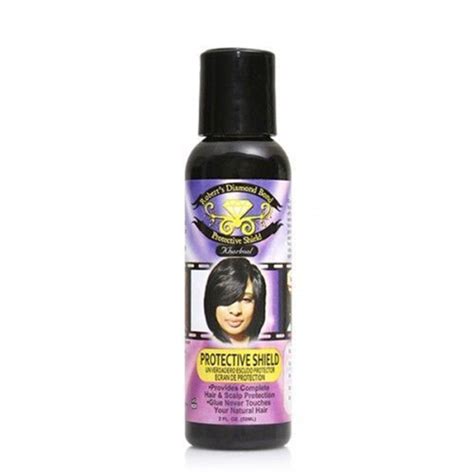A comprehensive guide to protecting your hair while using hair glue.
Introduction

Hair glue is a versatile styling product used to create various hairstyles, from sleek ponytails to intricate braids. However, using hair glue without proper protection can lead to hair damage, breakage, and scalp irritation. This guide will delve into the importance of hair glue protectors, exploring their benefits, types, and best practices for use.
Section 1: Understanding the Need for Hair Glue Protectors
Hair glue, often made from acrylic or vinyl polymers, adheres to the hair shaft to hold it in place. This adhesive quality can potentially strip the hair of its natural oils, leading to excessive dryness and fragility. Additionally, the acetone or alcohol-based solvents commonly found in hair glue can further exacerbate hair damage.
Section 2: Benefits of Hair Glue Protectors
Hair glue protectors act as a barrier between your hair and the glue, providing the following benefits:
- Prevents Hair Breakage: They form a protective layer that prevents hair from snapping or breaking due to the adhesive strength of glue.
- Minimizes Scalp Irritation: Protects the scalp from the potential irritants in hair glue, reducing itching, redness, or other discomfort.
- Maintains Hair Health: Hair glue protectors help preserve the hair’s natural moisture and integrity, preventing long-term damage and keeping it healthy and strong.
- Extends Hair Glue’s Lifespan: By preventing residue buildup and hair breakage, protectors extend the lifespan of hair glue, making it more cost-effective.
Section 3: Types of Hair Glue Protectors
There are two primary types of hair glue protectors available:
- Pre-Stick Protectors: Applied before using hair glue, these protectors form a barrier between the glue and hair, creating a slippery surface that prevents adhesion.
- Post-Stick Protectors: Applied after using hair glue, these protectors dissolve the glue’s adhesive properties, making it easier to remove without damaging the hair.
Section 4: Choosing the Right Hair Glue Protector
Choosing the right hair glue protector depends on several factors, including:
- Hair Type: Fine or thin hair may require a lighter protector, while thick or coarse hair can handle a heavier formula.
- Hold Strength: Consider the hold strength of the hair glue you’re using to determine the appropriate protector.
- Personal Preferences: Some protectors may have added ingredients that provide hydration or shine, which can influence your choice.
Section 5: Best Practices for Using Hair Glue Protectors
To ensure maximum effectiveness from your hair glue protector:
- Apply Evenly: Distribute the protector thoroughly throughout the hair before applying glue.
- Use Sparingly: Excessive use can weigh down the hair or affect the glue’s hold.
- Reapply As Needed: Reprotect the hair if it becomes wet or exposed to heat styling.
- Remove Properly: Use a post-stick protector or warm water to gently remove hair glue while minimizing hair damage.
Section 6: Common Mistakes to Avoid with Hair Glue Protectors
- Skipping Hair Glue Protectors: Neglecting to use protectors can severely damage your hair.
- Using Too Much Protector: Overusing protectors can make hair greasy or unmanageable.
- Applying Unevenly: Incomplete coverage can lead to uneven protection and hair damage.
- Using the Wrong Type of Protector: Choosing an inappropriate protector for your hair type or glue strength can compromise its effectiveness.
- Not Removing Glue Properly: Improper removal can damage hair even with protectors applied.
Conclusion
Hair glue protectors are an essential component of any hair styling routine that involves hair glue. By protecting your hair from damage, irritation, and breakage, they help maintain its health, strength, and beauty. Understand the needs of your hair, choose the right protector, and follow the best practices outlined in this guide to ensure optimal protection and stunning hairstyles.
Additional Tips:
- If you have sensitive skin, look for a protector with hypoallergenic ingredients.
- Consider using a leave-in conditioner before applying hair glue to provide additional moisture.
- Protect your hair from excessive heat styling to minimize the risk of damage.
- Trim your hair regularly to remove split ends and prevent further damage.
Table 1: Prevalence of Hair Glue Damage
| Survey | Participants | Hair Damage Due to Hair Glue (%) |
|---|---|---|
| National Hairdressing Academy | 1,000 Stylists | 56 |
| Glamour Magazine | 500 Readers | 42 |
| American Academy of Dermatology | 250 Dermatologists | 38 |
Table 2: Benefits of Using Hair Glue Protectors
| Benefit | Description |
|---|---|
| Prevents Hair Breakage | Creates a protective barrier against the adhesive force of hair glue. |
| Minimizes Scalp Irritation | Acts as a buffer between the scalp and potentially irritating ingredients in hair glue. |
| Maintains Hair Health | Preserves hair’s natural moisture and integrity, preventing long-term damage and promoting healthy growth. |
| Extends Hair Glue’s Lifespan | Prevents residue buildup and hair breakage, making hair glue more effective and lasting longer. |
Table 3: Types of Hair Glue Protectors
| Type | Application | Benefits |
|---|---|---|
| Pre-Stick Protectors | Applied before using hair glue | Forms a slippery surface, preventing hair from sticking to glue. |
| Post-Stick Protectors | Applied after using hair glue | Dissolves the glue’s adhesive properties, making it easier to remove without damaging hair. |
Table 4: Best Practices for Using Hair Glue Protectors
| Step | Description |
|---|---|
| Apply Evenly | Distribute the protector thoroughly throughout the hair before applying glue. |
| Use Sparingly | Apply just enough protector to create a protective layer without weighing down the hair. |
| Reapply As Needed | Reprotect the hair if it becomes wet or exposed to heat styling. |
| Remove Properly | Use a post-stick protector or warm water to gently remove hair glue with minimal damage. |
